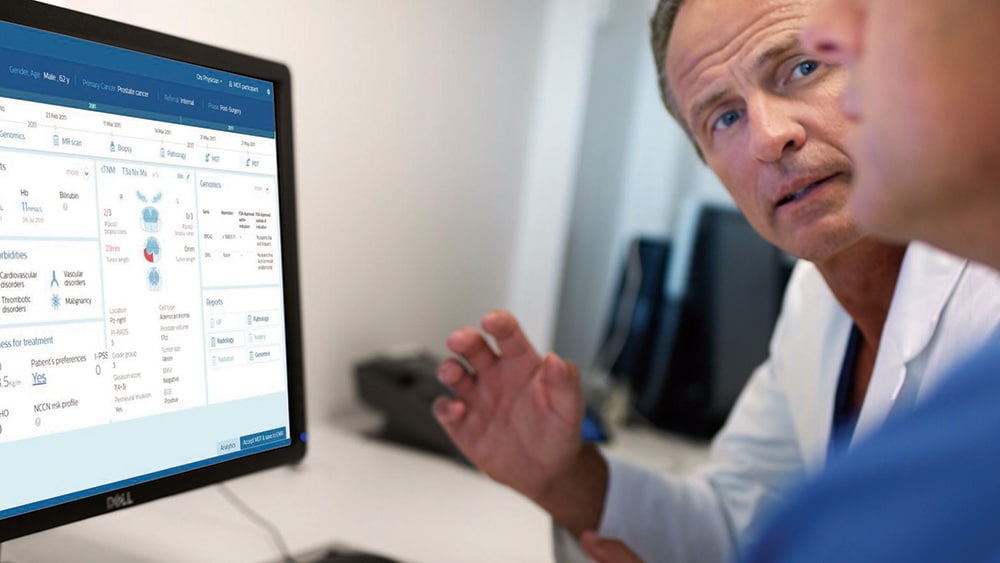Healthcare leaders are embracing the benefits of the cloud and software as a service (SaaS) after the pandemic challenged them to adapt and innovate like never before. 66% of them expect to move their technology infrastructures to the cloud this year – a number that is set to rise to 96% by 2024 [1]. Yet moving to the cloud is more than just a technology transformation. It’s an organizational transformation. Through cloud-based platforms and solutions, healthcare systems can begin to unlock clinical and operational insights at scale while speeding up innovation cycles for continuous value delivery.
The future never seems obvious – until it arrives. Who would have thought 25 years ago that today we would feel comfortable transferring money online without a moment’s hesitation? Or that we would be able to stream our favorite movies and series wherever we go? Or that cars would be able to connect to the internet, turning vehicles into software on wheels that can be upgraded over the air?
Cloud-based data storage and computing, as well as Software as a Service (SaaS) delivered through the cloud, have become ingrained in many aspects of our lives. Adoption in healthcare, however, has traditionally lagged behind. And for understandable reasons, the most important being concerns about security and regulatory compliance. Yet despite the initial hesitation, a growing number of healthcare leaders has begun to embrace the cloud, recognizing that cloud platforms purpose-built for healthcare – and the solutions built on top of them – can help pave the way to more cost-effective and connected care, in a highly secure and scalable way.
Integrating data across the care continuum
In many ways, COVID-19 catapulted healthcare into the future. The pandemic created a new urgency for healthcare leaders to expand their virtual care offerings as a way of connecting with patients beyond the walls of the hospital. At the same time, they wanted the flexibility to scale up or down without large upfront capital expenditures. Effective crisis management also required the rapid exchange of patient information across systems and care settings. Thanks to the flexibility of pay-as-you-go cloud-based services and solutions, healthcare providers were able to quickly scale up digital health technologies to meet new demands. As a result, the acceptance of cloud has increased remarkably [2].
The new reality of distributed healthcare is not going away. Virtual care such as remote cardiac monitoring is turning into a mainstay, helping healthcare providers save costs while extending their line of sight to support care transitions from the hospital to the home. Wearable biosensors can transmit data directly to the cloud, supporting clinical decision-making from a distance. And through remote collaboration between care providers, healthcare systems can make specialist expertise more widely available to address pressing staff shortages and skill gaps. Virtual hub-and-spoke models such as the Radiology Operations Command Center are a case in point, offering staff in geographically dispersed locations remote assistance from a central team of highly experienced specialists. All while offering the flexibility to scale up or down as demands evolve, without being locked into fixed capital expenses or having to install new systems.

With patient data being generated in an increasing number of settings and through different systems and modalities, integration of that data along the patient journey is also becoming more important.
Take cancer care, for example. Today, time-pressed physicians often scramble to find all the data they need, with limited interoperability between different data sources making it hard to see the big picture. Secure cloud-based solutions can help to generate a more unified and longitudinal patient view by pulling together data from different hospital systems, thereby supporting in-person or virtual tumor board meetings for collaborative decision-making. Add to that the possibility of collecting patient-reported outcomes in the comfort of a patient’s home, and we begin to see the contours of truly connected and patient-centered precision care.
Keeping patient data secure and compliant
As healthcare leaders embark on this journey to the cloud, data protection is a critical consideration. Data processing in healthcare must comply with rigorous standards, whether it is HIPAA in the US or GDPR in the EU. Unfortunately, healthcare organizations also remain a top target for data breaches, calling for additional data security protection measures [3].
While the need for data security and regulatory compliance has historically motivated healthcare organizations to keep data on premises, today there is a growing awareness that moving to the cloud can in fact be the better road to travel. In fact, 60% of healthcare leaders now cite security as one of the top benefits of the cloud [4]. When healthcare organizations rely on their own data centers, they are responsible for security from end to end, which can become prohibitively complex and time-consuming as IT infrastructures expand over time. Cloud-based services and solutions can reduce dependency on local hardware to store sensitive data while automated software updates keep systems current.
Of course, all of this needs to happen in accordance with local healthcare regulations. That’s why, when we developed our HealthSuite platform, we built in the privacy, security, and regulatory controls that meet the unique and often region-specific requirements of healthcare. This enables our customers, our innovation partners, and our own developers to build and implement secure and healthcare-compliant cloud applications at scale.

Turning data into insights at scale at the point of care
Working from these foundations, the next big opportunity in healthcare is to capture the insights in the data that we are beginning to connect and integrate. This is where the cloud is also turning into a vital enabler, with its powerful computing resources and advanced machine learning capabilities, offered as microservices. These microservices provide the building blocks to develop new digital solutions that, once validated and approved, can be deployed at scale to help improve clinical outcomes and operational efficiency.
For example, in radiology, we can augment the capabilities of human readers with cloud-based algorithms that help them spot abnormalities in medical images such as chest X-rays, allowing them to prioritize workloads, enhance diagnostic confidence, and ultimately enable a more precise diagnosis. As cloud maturity in healthcare grows, we will increasingly see such algorithms being deployed on top of a hospital’s installed base of medical equipment, putting relevant insights into the hands of physicians and staff when and where they need them. With SaaS-based models, healthcare providers can then benefit from regular upgrades over time as algorithms become more accurate by learning from new data.
Via the cloud, healthcare organizations will also be able to tap into third-party algorithms more easily, for example from startups. Cloud-based software marketplaces, combined with solutions that ensure seamless integration into clinical workflows, allow healthcare professionals to pick and deploy algorithms according to their needs, paying only for the ones they use.

On the operational front, predictive algorithms can continuously monitor medical equipment to help identify impending maintenance needs and thereby prevent avoidable downtime. We are moving to a world where medical systems and devices will all have their digital twin or virtual representation in the cloud, allowing healthcare administrators to monitor and manage their fleet from any location for optimal usage and patient care. Tailored suggestions can help them run their operations more efficiently, for example by pointing them to relevant applications they are not using yet, or by highlighting opportunities to improve patient scheduling and throughput.
Enabling rapid experimentation and continuous value delivery
Embracing the cloud also changes the very nature of innovation in healthcare.
Healthcare-compliant cloud platforms offer a flexible foundation for rapid development and testing of digital applications. Cross-functional teams working in short and agile cycles can put new digital applications into the hands of physicians or patients more quickly, and then add new or improved features and functionalities as they gather additional user feedback. That means healthcare organizations get to innovate faster. And in smaller, more digestible increments.
Traditionally, healthcare leaders looking to embrace new technologies have had to go through annual capital-based budgeting cycles or adopt solutions in one sweeping implementation, slowing down the speed of innovation. With rapidly evolving patient needs and accelerating technological advances, the cloud enables healthcare providers to experiment more quickly – and then double down on what works, while discarding what doesn’t.
At Philips, we are also embracing this shift towards continuous innovation to deepen our relationships with customers and deliver ever more value to them through modular and upgradable solutions –– much like the apps on your smartphone or the software in a smart and connected car offer new or improved features with every update.
Increasingly, we have development and operations teams working together across the entire application life cycle, from development and testing to deployment and operations (DevOps). Working back from customer needs, the joint focus of such end-to-end teams is to rapidly deliver and upgrade innovations that support physicians and staff in their mission of improving the lives of patients.
To do this effectively, we leverage a global network of clinical innovation partnerships. This enables us to disseminate the most recent and proven expert knowledge more quickly by making it widely available through the cloud. For example, in oncology, treatments are evolving faster than clinical teams can keep up with, making it increasingly difficult to select the most appropriate treatment for each patient. Through our partnership with the Dana-Farber Cancer Institute, we are able to offer cancer care teams recommendations for specific therapies or clinical trials, tailored to the patient’s characteristics. As new clinical knowledge and user feedback is gathered, new software updates can be deployed through the cloud to cancer care teams worldwide – putting up-to-date best practices at their fingertips. That’s how cloud-based innovation can boost the accessibility, quality, and equity of patient care.

Moving to the cloud is not all or nothing
Of course, none of this is to suggest that moving to the cloud is like switching a button. It’s a complex and multi-year journey for most of our customers. And it’s quite a journey for Philips, too. Any organization that has accumulated a large number of legacy systems and infrastructures over the years will have to manage a hybrid architecture during their journey to the cloud [5].
There’s also a strong case for keeping certain types of data processing close to where the data is collected.
For example, in minimally invasive image-guided therapy, where interventional physicians navigate tiny catheters through the human body, accurate hand-eye coordination requires real-time visual guidance. It makes much more sense to run such real-time and safety-critical applications in the interventional room itself, with data being processed locally. However, these applications could still be updated via the cloud on a regular basis, to ensure access to the latest version. The cloud can also serve as a powerful tool to develop new algorithms that help plan, guide, or document procedures, which can then be implemented locally to support interventional physicians in their daily workflows.
In essence, the cloud is a means to an end – not a goal in itself.
In combination with a secure and interoperable network of connections to on-premises hospital systems, cloud-based solutions represent a great opportunity for healthcare leaders to unlock the value of data generated along the patient journey, from the hospital to the home. By turning data into insights at scale, we can empower healthcare professionals to practice at the top of their license, helping them deliver better outcomes at lower cost with improved patient and staff experience. Ultimately, this will transform healthcare systems – just like we’ve seen the cloud change other industries.
References
[1] Accenture Digital Health Technology Vision 2021. https://www.accenture.com/_acnmedia/PDF-156/Accenture-Digital-Health-Tech-Vision-2021.pdf
[2] Cresswell, K, Williams, R, & Sheikh, A. Using cloud technology in healthcare during the COVID-19 pandemic. The Lancet, 2021, 3:1. https://doi.org/10.1016/S2589-7500(20)30291-0
[3] https://www.devprojournal.com/industry/healthcare/healthcare-facilities-remain-a-top-target-for-data-breaches/
[4] https://www.accenture.com/_acnmedia/PDF-145/Accenture-Health-Content-Cloud-Imperative-in-Healthcare.pdf
[5] Ahead in the Cloud: Best Practices for Navigating the Future of Enterprise IT. 2018. Orban, S.
Share on social media
Topics
Authors

Henk van Houten
Former Chief Technology Officer at Royal Philips from 2016 to 2022

Kalavathi Gv
Global Head of SaaS Development, Royal Philips With more than 25 years of experience in healthcare technology innovation, Kalavathi leads Philips’ global transformation towards offering SaaS-based informatics solutions as part of our customer-first innovation strategy. She previously headed the Philips Innovation Campus in Bengaluru, India. Prior to that, she held multiple global leadership positions at Philips.

